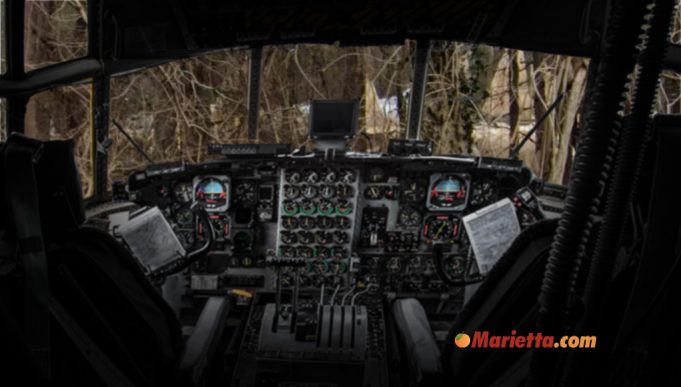Lockheed Martin, next to Dobbins Air Reserve Base in Marietta, is currently home to eight C-130 Hercules aircraft that were built for Libya in 1972. Libya’s Moammar Gadhafi paid $70 million for them, and soon after they were built, the planes were grounded due to political issues.
Shortly after taking power in Libya, Gadhafi closed American bases on Libyan territory and partially nationalized all foreign oil and commercial interests in Libya. In response, the U.S. implemented export controls on military equipment and civil aircraft. Because of this, the aircraft were never delivered, and remain at Lockheed Martin/Dobbins Air Reserve Base.
Views from Google Maps:
The aircraft in Marietta were painted in desert camouflage colors in preparation for a delivery that was never made. They were reportedly serviced for a few years, but they were later left to the elements are now likely closer to scrap metal than aircraft. Officially, they are property of Libya so they cannot be disposed of, and the State Department continues to pay the associated parking and storage fees charged by Lockheed Martin over the past half century.
The Legacy of the C-130 Hercules
The C-130 Hercules, a prominent figure in the realm of military transport aircraft, has etched its name in aviation history. Developed by Lockheed Martin, the prototype’s maiden flight in 1954 marked the beginning of a new era in military aviation. The C-130 was designed to meet the needs for a versatile and robust transport aircraft capable of performing a variety of missions.
Design and Capabilities
What sets the C-130 apart is its distinctive design and unparalleled capabilities. The aircraft features four turboprop engines, a hallmark of its power and reliability. Its ability to take off and land on rough, unprepared runways made it invaluable for military operations, humanitarian aid, and disaster relief missions. The C-130’s spacious cargo hold can transport troops, medical supplies, and large equipment, making it a critical asset in logistics.
Versatility and Adaptations
Over the years, the C-130 has seen numerous modifications, adapting to various roles beyond cargo transportation. These adaptations include aerial firefighting, weather reconnaissance, and even gunship roles. The aircraft’s versatility is further highlighted by its adoption by over 70 nations, underscoring its global impact.
C-130 Hercules Dimensions
The C-130 is 38 feet, 10 inches tall (11. 9 meters), 112 feet, 9 inches (34.69 meters) wide, and the wingspan is 132 feet, 7 inches (39.7 meters).
Continued Relevance and Future
Despite its age, the C-130 remains a key player in military and humanitarian operations worldwide. Its ongoing upgrades and variants, like the C-130J Super Hercules, ensure that this iconic aircraft continues to meet modern challenges.


















Prime Minister of Libya P Ali Zaidan in his last visit to the United States U.S. I said America will compensate Libya 8 new aircraft replacement for aircraft, which have become scrap
Hi!!!!
how I can get some news about this airplanes today?
Somebody know if this airplanes for sales ?
Thank you for to send your answer to my email.
Have nice day
not a chance in hell.
This is very interesting. I came out with a group of Reservist to take possession of 2 H models. On the tour of the facility, we were shown these C-130s. And that was over 20 something years ago.
So is anything new transpired?
Just curious.
It’s very interesting that for aircraft so close to being scrap metal they are buried behind so many barricades of trailers and rows of Conex.
If Libya can get replacement aircraft why can’t these be auctioned off? Its a waste of money. Who is the contact point for negotiation of these aircraft in question?
They can’t GET replacements. The Air Force and Libya are the points of contact.
lol they should deliver them now haha
The Libyan C-130s are not on Dobbins Air Reserve Base.